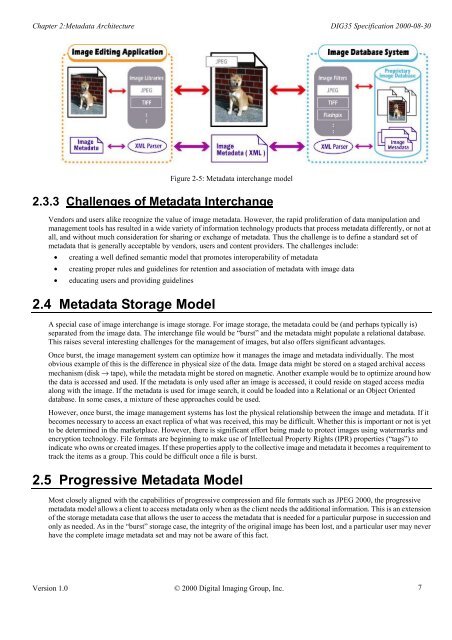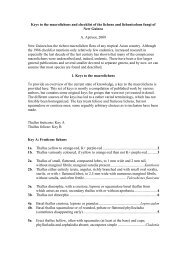DIG35 Specification: Metadata for Digital Images. Version 1.0
DIG35 Specification: Metadata for Digital Images. Version 1.0
DIG35 Specification: Metadata for Digital Images. Version 1.0
You also want an ePaper? Increase the reach of your titles
YUMPU automatically turns print PDFs into web optimized ePapers that Google loves.
Chapter 2:<strong>Metadata</strong> Architecture <strong>DIG35</strong> <strong>Specification</strong> 2000-08-30Figure 2-5: <strong>Metadata</strong> interchange model2.3.3 Challenges of <strong>Metadata</strong> InterchangeVendors and users alike recognize the value of image metadata. However, the rapid proliferation of data manipulation andmanagement tools has resulted in a wide variety of in<strong>for</strong>mation technology products that process metadata differently, or not atall, and without much consideration <strong>for</strong> sharing or exchange of metadata. Thus the challenge is to define a standard set ofmetadata that is generally acceptable by vendors, users and content providers. The challenges include:• creating a well defined semantic model that promotes interoperability of metadata• creating proper rules and guidelines <strong>for</strong> retention and association of metadata with image data• educating users and providing guidelines2.4 <strong>Metadata</strong> Storage ModelA special case of image interchange is image storage. For image storage, the metadata could be (and perhaps typically is)separated from the image data. The interchange file would be “burst” and the metadata might populate a relational database.This raises several interesting challenges <strong>for</strong> the management of images, but also offers significant advantages.Once burst, the image management system can optimize how it manages the image and metadata individually. The mostobvious example of this is the difference in physical size of the data. Image data might be stored on a staged archival accessmechanism (disk → tape), while the metadata might be stored on magnetic. Another example would be to optimize around howthe data is accessed and used. If the metadata is only used after an image is accessed, it could reside on staged access mediaalong with the image. If the metadata is used <strong>for</strong> image search, it could be loaded into a Relational or an Object Orienteddatabase. In some cases, a mixture of these approaches could be used.However, once burst, the image management systems has lost the physical relationship between the image and metadata. If itbecomes necessary to access an exact replica of what was received, this may be difficult. Whether this is important or not is yetto be determined in the marketplace. However, there is significant ef<strong>for</strong>t being made to protect images using watermarks andencryption technology. File <strong>for</strong>mats are beginning to make use of Intellectual Property Rights (IPR) properties (“tags”) toindicate who owns or created images. If these properties apply to the collective image and metadata it becomes a requirement totrack the items as a group. This could be difficult once a file is burst.2.5 Progressive <strong>Metadata</strong> ModelMost closely aligned with the capabilities of progressive compression and file <strong>for</strong>mats such as JPEG 2000, the progressivemetadata model allows a client to access metadata only when as the client needs the additional in<strong>for</strong>mation. This is an extensionof the storage metadata case that allows the user to access the metadata that is needed <strong>for</strong> a particular purpose in succession andonly as needed. As in the “burst” storage case, the integrity of the original image has been lost, and a particular user may neverhave the complete image metadata set and may not be aware of this fact.<strong>Version</strong> <strong>1.0</strong> © 2000 <strong>Digital</strong> Imaging Group, Inc. 7




